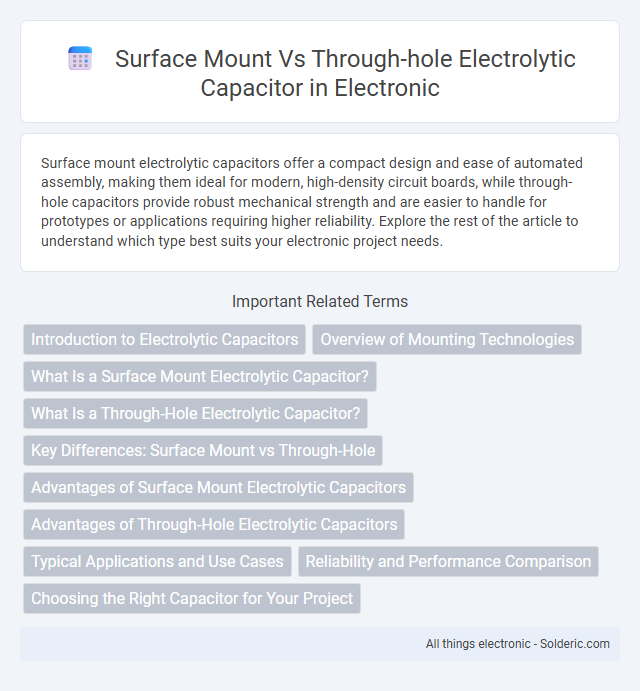Surface mount electrolytic capacitors offer a compact design and ease of automated assembly, making them ideal for modern, high-density circuit boards, while through-hole capacitors provide robust mechanical strength and are easier to handle for prototypes or applications requiring higher reliability. Explore the rest of the article to understand which type best suits your electronic project needs.
Comparison Table
| Feature | Surface Mount Electrolytic Capacitor | Through-Hole Electrolytic Capacitor |
|---|---|---|
| Mounting Type | Surface Mount Technology (SMT) | Leaded, inserted through holes on PCB |
| Size | Compact, smaller footprint | Larger, bulkier size |
| Assembly Process | Automated pick-and-place with reflow soldering | Manual or wave soldering, less automated |
| Electrical Performance | Typical capacitance range: 1uF to 1000uF Lower ESL and ESR |
Typical capacitance range: 1uF to 4700uF Higher ESL and ESR |
| Mechanical Strength | Less robust to mechanical stress | Better mechanical durability |
| Applications | High-density, automated electronics like smartphones | Power electronics, industrial equipment with vibration |
| Cost | Generally lower production cost due to automation | Higher labor and assembly cost |
Introduction to Electrolytic Capacitors
Electrolytic capacitors, key components in electronic circuits, are available in surface mount (SMD) and through-hole types, each designed for specific mounting methods and applications. Surface mount electrolytic capacitors offer compact sizes, automated assembly compatibility, and improved electrical performance for high-frequency circuits. Through-hole electrolytic capacitors provide robust mechanical strength and higher capacitance values, ideal for power supply filtering and situations requiring strong physical connections.
Overview of Mounting Technologies
Surface mount electrolytic capacitors are designed for automated placement on printed circuit boards (PCBs), offering smaller sizes and better performance at high frequencies compared to through-hole types. Through-hole electrolytic capacitors feature leads that pass through PCB holes, providing robust mechanical stability ideal for applications subject to mechanical stress or thermal cycling. Your choice between surface mount and through-hole capacitors depends on factors such as assembly method, board space constraints, and durability requirements.
What Is a Surface Mount Electrolytic Capacitor?
A surface mount electrolytic capacitor is a compact, electronically polarized component designed for automated PCB assembly, featuring flat terminals that solder directly onto the board's surface. Unlike through-hole capacitors that require leads inserted into drilled holes, surface mount types save space and enhance circuit density, making them ideal for modern, high-density electronic designs. Your choice between surface mount and through-hole capacitors depends on factors like assembly method, size constraints, and electrical performance.
What Is a Through-Hole Electrolytic Capacitor?
A through-hole electrolytic capacitor features axial or radial leads that pass through drilled holes on a printed circuit board (PCB) and are soldered on the opposite side, providing strong mechanical bonds. These capacitors typically offer higher capacitance values and voltage ratings compared to surface mount counterparts, making them ideal for power supply filtering and audio applications. Their larger size allows for better heat dissipation and durability in high-stress environments, which is critical in industrial and automotive electronics.
Key Differences: Surface Mount vs Through-Hole
Surface mount electrolytic capacitors offer a compact design with lower inductance suitable for high-frequency applications, while through-hole types provide robust mechanical strength and higher voltage ratings for demanding power circuits. Surface mount capacitors enable automated placement on densely populated printed circuit boards (PCBs), contrasting with through-hole capacitors that require manual or wave soldering processes. Thermal performance varies, as through-hole capacitors dissipate heat more effectively due to lead length and board penetration, influencing reliability in high-temperature environments.
Advantages of Surface Mount Electrolytic Capacitors
Surface mount electrolytic capacitors offer significant advantages such as smaller size, which enables higher component density on PCBs, improving overall device miniaturization. Their automated placement compatibility reduces manufacturing costs and enhances production speed, benefiting mass production efficiency. You gain better electrical performance with lower inductance and improved high-frequency characteristics, ideal for modern electronic circuit designs.
Advantages of Through-Hole Electrolytic Capacitors
Through-hole electrolytic capacitors offer superior mechanical stability and durability, making them ideal for circuits subject to vibration or physical stress. They typically provide higher capacitance values and voltage ratings compared to surface mount types, supporting more demanding applications. Your choice of through-hole capacitors ensures enhanced reliability in power supply filtering and audio amplifier circuits.
Typical Applications and Use Cases
Surface mount electrolytic capacitors are commonly used in compact electronic devices like smartphones, laptops, and modern automotive electronics due to their small size and efficient heat dissipation. Through-hole electrolytic capacitors are preferred in power supply circuits, industrial equipment, and high-reliability applications where mechanical strength and higher capacitance values are crucial. Your choice between these capacitor types depends on factors such as circuit size constraints, mechanical durability, and the required electrical performance.
Reliability and Performance Comparison
Surface mount electrolytic capacitors offer superior vibration resistance and improved thermal performance compared to through-hole types, enhancing overall reliability in compact electronic assemblies. Through-hole electrolytic capacitors generally provide higher voltage ratings and better durability under mechanical stress, making them suitable for rugged applications. Your choice between these capacitors should consider the specific operating environment and performance requirements to ensure optimal functionality and longevity.
Choosing the Right Capacitor for Your Project
Choosing the right capacitor depends on your project's space constraints and electrical requirements; surface mount electrolytic capacitors offer compact size and better high-frequency performance ideal for densely packed PCBs, while through-hole electrolytic capacitors provide robust mechanical strength and higher capacitance values suitable for power circuits. Consider the operating temperature range, ripple current rating, and voltage tolerance to ensure reliability and longevity in your specific application. Selecting an appropriate capacitor type enhances circuit stability and optimizes overall device performance.
surface mount vs through-hole electrolytic capacitor Infographic

 solderic.com
solderic.com